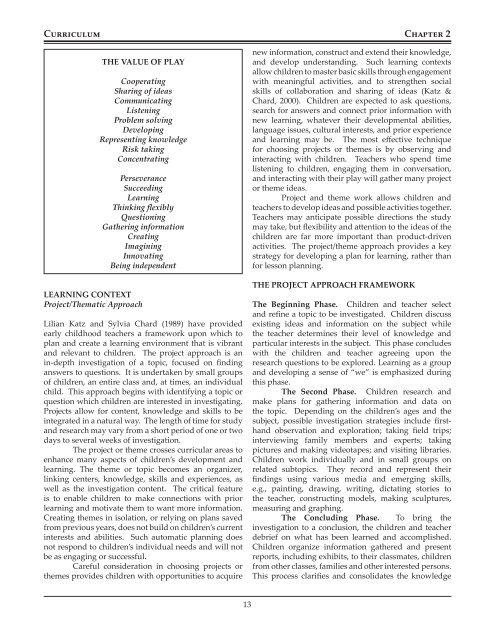Early Childhood
Early Childhood
Early Childhood
You also want an ePaper? Increase the reach of your titles
YUMPU automatically turns print PDFs into web optimized ePapers that Google loves.
Curriculum Chapter 2<br />
THE VALUE OF PLAY<br />
Cooperating<br />
Sharing of ideas<br />
Communicating<br />
Listening<br />
Problem solving<br />
Developing<br />
Representing knowledge<br />
Risk taking<br />
Concentrating<br />
Perseverance<br />
Succeeding<br />
Learning<br />
Thinking flexibly<br />
Questioning<br />
Gathering information<br />
Creating<br />
Imagining<br />
Innovating<br />
Being independent<br />
LEARNING CONTEXT<br />
Project/Thematic Approach<br />
Lilian Katz and Sylvia Chard (1989) have provided<br />
early childhood teachers a framework upon which to<br />
plan and create a learning environment that is vibrant<br />
and relevant to children. The project approach is an<br />
in-depth investigation of a topic, focused on finding<br />
answers to questions. It is undertaken by small groups<br />
of children, an entire class and, at times, an individual<br />
child. This approach begins with identifying a topic or<br />
question which children are interested in investigating.<br />
Projects allow for content, knowledge and skills to be<br />
integrated in a natural way. The length of time for study<br />
and research may vary from a short period of one or two<br />
days to several weeks of investigation.<br />
The project or theme crosses curricular areas to<br />
enhance many aspects of children’s development and<br />
learning. The theme or topic becomes an organizer,<br />
linking centers, knowledge, skills and experiences, as<br />
well as the investigation content. The critical feature<br />
is to enable children to make connections with prior<br />
learning and motivate them to want more information.<br />
Creating themes in isolation, or relying on plans saved<br />
from previous years, does not build on children’s current<br />
interests and abilities. Such automatic planning does<br />
not respond to children’s individual needs and will not<br />
be as engaging or successful.<br />
Careful consideration in choosing projects or<br />
themes provides children with opportunities to acquire<br />
13<br />
new information, construct and extend their knowledge,<br />
and develop understanding. Such learning contexts<br />
allow children to master basic skills through engagement<br />
with meaningful activities, and to strengthen social<br />
skills of collaboration and sharing of ideas (Katz &<br />
Chard, 2000). Children are expected to ask questions,<br />
search for answers and connect prior information with<br />
new learning, whatever their developmental abilities,<br />
language issues, cultural interests, and prior experience<br />
and learning may be. The most effective technique<br />
for choosing projects or themes is by observing and<br />
interacting with children. Teachers who spend time<br />
listening to children, engaging them in conversation,<br />
and interacting with their play will gather many project<br />
or theme ideas.<br />
Project and theme work allows children and<br />
teachers to develop ideas and possible activities together.<br />
Teachers may anticipate possible directions the study<br />
may take, but flexibility and attention to the ideas of the<br />
children are far more important than product-driven<br />
activities. The project/theme approach provides a key<br />
strategy for developing a plan for learning, rather than<br />
for lesson planning.<br />
THE PROJECT APPROACH FRAMEWORK<br />
The Beginning Phase. Children and teacher select<br />
and refine a topic to be investigated. Children discuss<br />
existing ideas and information on the subject while<br />
the teacher determines their level of knowledge and<br />
particular interests in the subject. This phase concludes<br />
with the children and teacher agreeing upon the<br />
research questions to be explored. Learning as a group<br />
and developing a sense of “we” is emphasized during<br />
this phase.<br />
The Second Phase. Children research and<br />
make plans for gathering information and data on<br />
the topic. Depending on the children’s ages and the<br />
subject, possible investigation strategies include firsthand<br />
observation and exploration; taking field trips;<br />
interviewing family members and experts; taking<br />
pictures and making videotapes; and visiting libraries.<br />
Children work individually and in small groups on<br />
related subtopics. They record and represent their<br />
findings using various media and emerging skills,<br />
e.g., painting, drawing, writing, dictating stories to<br />
the teacher, constructing models, making sculptures,<br />
measuring and graphing.<br />
The Concluding Phase. To bring the<br />
investigation to a conclusion, the children and teacher<br />
debrief on what has been learned and accomplished.<br />
Children organize information gathered and present<br />
reports, including exhibits, to their classmates, children<br />
from other classes, families and other interested persons.<br />
This process clarifies and consolidates the knowledge


